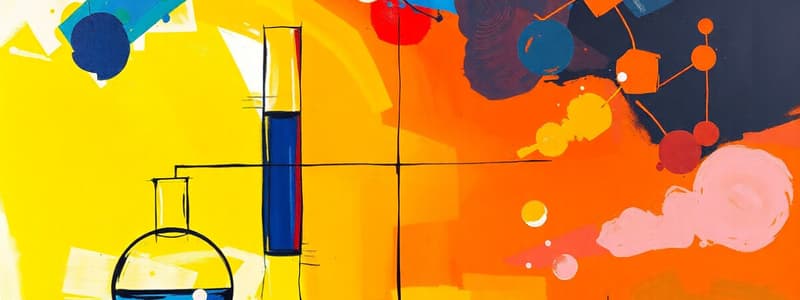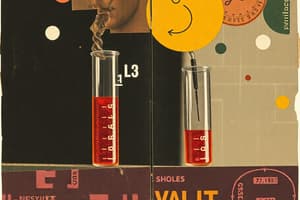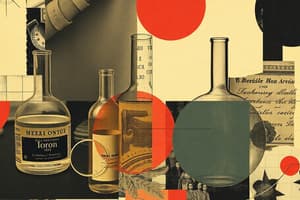Podcast
Questions and Answers
For the reversible reaction $A(g) + B(g)
ightleftharpoons 2C(g)$, increasing the total pressure by adding an inert gas at constant volume will:
For the reversible reaction $A(g) + B(g) ightleftharpoons 2C(g)$, increasing the total pressure by adding an inert gas at constant volume will:
- Have no effect on the equilibrium position. (correct)
- Change the value of the equilibrium constant, K.
- Shift the equilibrium towards the product side.
- Shift the equilibrium towards the reactant side.
Consider an exothermic reaction at equilibrium. Which of the following actions will simultaneously shift the equilibrium towards the reactants and decrease the value of the equilibrium constant (K)?
Consider an exothermic reaction at equilibrium. Which of the following actions will simultaneously shift the equilibrium towards the reactants and decrease the value of the equilibrium constant (K)?
- Increasing the temperature and decreasing the concentration of reactants. (correct)
- Decreasing the temperature and increasing the pressure (assuming Δn > 0).
- Decreasing the pressure (assuming Δn < 0) and adding more products.
- Increasing the temperature and adding a catalyst.
For the reaction $2SO_2(g) + O_2(g)
ightleftharpoons 2SO_3(g)$, ΔH < 0. Which change will NOT increase the production of $SO_3(g)$?
For the reaction $2SO_2(g) + O_2(g) ightleftharpoons 2SO_3(g)$, ΔH < 0. Which change will NOT increase the production of $SO_3(g)$?
- Increasing the pressure.
- Adding more $O_2(g)$.
- Decreasing the temperature.
- Adding an inert gas at constant volume. (correct)
A reaction has an equilibrium constant K = 0.5 at 25°C. If the reaction is endothermic, what will happen to the value of K if the temperature is increased to 50°C?
A reaction has an equilibrium constant K = 0.5 at 25°C. If the reaction is endothermic, what will happen to the value of K if the temperature is increased to 50°C?
Consider the equilibrium: $A(g) + B(s)
ightleftharpoons C(g)$. Which of the following changes will shift the equilibrium to the right?
Consider the equilibrium: $A(g) + B(s) ightleftharpoons C(g)$. Which of the following changes will shift the equilibrium to the right?
For the reaction $N_2(g) + 3H_2(g)
ightleftharpoons 2NH_3(g)$ at equilibrium, what effect will decreasing the volume of the container have?
For the reaction $N_2(g) + 3H_2(g) ightleftharpoons 2NH_3(g)$ at equilibrium, what effect will decreasing the volume of the container have?
Which of the following statements is correct regarding the effect of a catalyst on a reversible reaction at equilibrium?
Which of the following statements is correct regarding the effect of a catalyst on a reversible reaction at equilibrium?
Which of the following scenarios will always shift the equilibrium towards the product side?
Which of the following scenarios will always shift the equilibrium towards the product side?
How does decreasing the temperature affect an endothermic reaction at equilibrium?
How does decreasing the temperature affect an endothermic reaction at equilibrium?
Consider a reaction in which Δn = 0 (no change in the number of moles of gas). Which of the following changes will affect the equilibrium?
Consider a reaction in which Δn = 0 (no change in the number of moles of gas). Which of the following changes will affect the equilibrium?
In the Haber-Bosch process ($N_2 + 3H_2
ightleftharpoons 2NH_3$, ΔH < 0), which conditions favor the production of ammonia?
In the Haber-Bosch process ($N_2 + 3H_2 ightleftharpoons 2NH_3$, ΔH < 0), which conditions favor the production of ammonia?
Which action will increase the value of the equilibrium constant (K) for an endothermic reaction?
Which action will increase the value of the equilibrium constant (K) for an endothermic reaction?
For the equilibrium $2NO_2(g)
ightleftharpoons N_2O_4(g)$, the reaction is exothermic. Predict the effect of increasing the temperature on the equilibrium.
For the equilibrium $2NO_2(g) ightleftharpoons N_2O_4(g)$, the reaction is exothermic. Predict the effect of increasing the temperature on the equilibrium.
Which of the following changes affects the value of the equilibrium constant (K)?
Which of the following changes affects the value of the equilibrium constant (K)?
For the reaction $A(g)
ightleftharpoons B(g) + C(g)$, increasing the pressure will:
For the reaction $A(g) ightleftharpoons B(g) + C(g)$, increasing the pressure will:
Which of the following will increase the production of products in an exothermic reaction at equilibrium?
Which of the following will increase the production of products in an exothermic reaction at equilibrium?
What effect does increasing the concentration of a reactant have on a system at equilibrium?
What effect does increasing the concentration of a reactant have on a system at equilibrium?
Which change will NOT affect the equilibrium position for the reaction $H_2(g) + I_2(g)
ightleftharpoons 2HI(g)$?
Which change will NOT affect the equilibrium position for the reaction $H_2(g) + I_2(g) ightleftharpoons 2HI(g)$?
Consider the reaction $CO(g) + 2H_2(g)
ightleftharpoons CH_3OH(g)$. ΔH < 0. Which conditions will favor the production of $CH_3OH(g)$?
Consider the reaction $CO(g) + 2H_2(g) ightleftharpoons CH_3OH(g)$. ΔH < 0. Which conditions will favor the production of $CH_3OH(g)$?
How does decreasing the pressure affect the equilibrium of a reaction in which there are more moles of gas on the product side than on the reactant side?
How does decreasing the pressure affect the equilibrium of a reaction in which there are more moles of gas on the product side than on the reactant side?
In the reaction $A(g) + B(g)
ightleftharpoons C(g) + D(g)$, the forward reaction is endothermic. Which conditions will favor the formation of C and D?
In the reaction $A(g) + B(g) ightleftharpoons C(g) + D(g)$, the forward reaction is endothermic. Which conditions will favor the formation of C and D?
If Q < K for a reversible reaction, what will happen?
If Q < K for a reversible reaction, what will happen?
Which of the following changes will decrease the value of K for an exothermic reaction?
Which of the following changes will decrease the value of K for an exothermic reaction?
For the reaction $N_2O_4(g)
ightleftharpoons 2NO_2(g)$, the reaction is endothermic. What will happen if the temperature is decreased?
For the reaction $N_2O_4(g) ightleftharpoons 2NO_2(g)$, the reaction is endothermic. What will happen if the temperature is decreased?
Adding an inert gas at constant pressure to a reaction at equilibrium will:
Adding an inert gas at constant pressure to a reaction at equilibrium will:
Which of the following correctly describes the effect of removing products from a system at equilibrium?
Which of the following correctly describes the effect of removing products from a system at equilibrium?
For the reversible reaction: $2A(g) + B(g)
ightleftharpoons C(s) + D(g)$, which of the following actions would increase the amount of $C(s)$ at equilibrium?
For the reversible reaction: $2A(g) + B(g) ightleftharpoons C(s) + D(g)$, which of the following actions would increase the amount of $C(s)$ at equilibrium?
How do changes in pressure typically affect reactions in solution?
How do changes in pressure typically affect reactions in solution?
Which of the following actions will not change the composition of an equilibrium mixture?
Which of the following actions will not change the composition of an equilibrium mixture?
For an endothermic reaction, what happens to the equilibrium constant K as temperature decreases?
For an endothermic reaction, what happens to the equilibrium constant K as temperature decreases?
If a reversible reaction has Δn = 0, which of the following changes will alter the equilibrium composition?
If a reversible reaction has Δn = 0, which of the following changes will alter the equilibrium composition?
The Contact process ($2SO_2(g) + O_2(g)
ightleftharpoons 2SO_3(g)$) is exothermic. Which strategy will maximize $SO_3$ production?
The Contact process ($2SO_2(g) + O_2(g) ightleftharpoons 2SO_3(g)$) is exothermic. Which strategy will maximize $SO_3$ production?
How does Le Chatelier's principle apply to biological systems?
How does Le Chatelier's principle apply to biological systems?
For a reaction with Q > K, which direction will the reaction proceed to reach equilibrium?
For a reaction with Q > K, which direction will the reaction proceed to reach equilibrium?
Which of the following is NOT a way to shift the equilibrium of a chemical reaction?
Which of the following is NOT a way to shift the equilibrium of a chemical reaction?
If a reaction is at equilibrium and more product is added, what happens to the reaction quotient, Q?
If a reaction is at equilibrium and more product is added, what happens to the reaction quotient, Q?
For a gas-phase reaction, increasing the volume of the container will shift the equilibrium in which direction?
For a gas-phase reaction, increasing the volume of the container will shift the equilibrium in which direction?
In an endothermic reaction, if temperature decreases, what occurs to the equilibrium?
In an endothermic reaction, if temperature decreases, what occurs to the equilibrium?
Flashcards
Le Chatelier's Principle
Le Chatelier's Principle
A principle stating that if a condition change is applied to a system in equilibrium, the system will shift to relieve the stress.
Adding Reactants
Adding Reactants
Shifting equilibrium towards the side of the reaction that consumes the added reactants.
Adding Products
Adding Products
Shifting equilibrium towards the side of the reaction that consumes the added products.
Removing Reactants
Removing Reactants
Signup and view all the flashcards
Removing Products
Removing Products
Signup and view all the flashcards
Inert Gases
Inert Gases
Signup and view all the flashcards
Solids/Liquids and Equilibrium
Solids/Liquids and Equilibrium
Signup and view all the flashcards
Catalysts
Catalysts
Signup and view all the flashcards
Endothermic Reactions & Increasing Temperature
Endothermic Reactions & Increasing Temperature
Signup and view all the flashcards
Endothermic Reactions & Decreasing Temperature
Endothermic Reactions & Decreasing Temperature
Signup and view all the flashcards
Exothermic Reactions & Increasing Temperature
Exothermic Reactions & Increasing Temperature
Signup and view all the flashcards
Exothermic Reactions & Decreasing Temperature
Exothermic Reactions & Decreasing Temperature
Signup and view all the flashcards
ΔH
ΔH
Signup and view all the flashcards
Increasing Pressure
Increasing Pressure
Signup and view all the flashcards
Decreasing Pressure
Decreasing Pressure
Signup and view all the flashcards
No Change in Gas Moles
No Change in Gas Moles
Signup and view all the flashcards
Addition of Inert Gas
Addition of Inert Gas
Signup and view all the flashcards
Changes in Volume
Changes in Volume
Signup and view all the flashcards
Reactions in Solution
Reactions in Solution
Signup and view all the flashcards
Equilibrium Constant (K)
Equilibrium Constant (K)
Signup and view all the flashcards
Exothermic Reactions and K
Exothermic Reactions and K
Signup and view all the flashcards
Concentration/Pressure
Concentration/Pressure
Signup and view all the flashcards
Reaction Quotient (Q)
Reaction Quotient (Q)
Signup and view all the flashcards
Haber-Bosch Process
Haber-Bosch Process
Signup and view all the flashcards
Contact Process
Contact Process
Signup and view all the flashcards
Industrial Chemistry
Industrial Chemistry
Signup and view all the flashcards
Biological Systems
Biological Systems
Signup and view all the flashcards
Study Notes
- Le Chatelier's principle states that if a change of condition is applied to a system in equilibrium, the system will shift in a direction that relieves the stress.
- The principle predicts how equilibrium changes when altering reactant concentration, product concentration, temperature, or pressure.
Changes in Concentration
- Adding reactants shifts equilibrium towards the product side, consuming added reactants.
- Adding products shifts equilibrium towards the reactant side, consuming added products.
- Removing reactants shifts equilibrium towards the reactant side, producing more reactants.
- Removing products shifts equilibrium towards the product side, producing more products.
- Inert gases (e.g., noble gases) do not participate in reactions and have no effect on equilibrium position.
- Presence of inert gasses increases total pressure but does not affect partial pressures of reactants or products.
- Adding or removing pure solids or liquids does not affect equilibrium, due to their constant concentrations.
- Catalysts speed up forward and reverse reactions equally, decreasing the time to reach equilibrium without changing the equilibrium position.
Changes in Temperature
- For endothermic reactions (ΔH > 0), increasing temperature shifts equilibrium towards the product side, favoring the forward reaction.
- For endothermic reactions, decreasing temperature shifts equilibrium towards the reactant side, favoring the reverse reaction.
- For exothermic reactions (ΔH < 0), increasing temperature shifts equilibrium towards the reactant side, favoring the reverse reaction.
- For exothermic reactions, decreasing temperature shifts equilibrium towards the product side, favoring the forward reaction.
- ΔH represents the enthalpy change of the reaction, where a positive value indicates an endothermic reaction and a negative value indicates an exothermic reaction.
Changes in Pressure
- Pressure changes affect reactions involving gases, especially with a change in the number of moles of gas.
- Increasing pressure shifts equilibrium towards the side with fewer moles of gas.
- Decreasing pressure shifts equilibrium towards the side with more moles of gas.
- If there's no change in the number of moles of gas (Δn = 0), pressure changes have negligible effects on equilibrium.
- Adding an inert gas at constant volume increases total pressure but doesn't affect partial pressures, thus having no effect on equilibrium.
- Volume changes affect pressure, subsequently shifting equilibrium: decreasing volume favors fewer gas moles, while increasing volume favors more gas moles.
- Pressure changes typically do not significantly affect reactions in solution unless gases are involved and highly compressed.
Mathematical Representation
- The equilibrium constant (K) is affected by temperature changes.
- For endothermic reactions, increasing temperature increases K, while decreasing temperature decreases K.
- For exothermic reactions, increasing temperature decreases K, while decreasing temperature increases K.
- Changes in concentration or pressure do not change the value of K; instead, the reaction quotient (Q) temporarily differs from K, driving the system towards equilibrium.
- The reaction quotient (Q) measures the relative amount of products and reactants at any given time.
- When Q < K, the reaction proceeds forward; when Q > K, the reaction proceeds in reverse; when Q = K, the system is at equilibrium.
Applications
- The Haber-Bosch process for ammonia synthesis (N2 + 3H2 ⇌ 2NH3) uses high pressure and moderate temperature to favor ammonia production (exothermic reaction).
- The Contact process for sulfuric acid production involves multiple equilibrium steps, including the oxidation of SO2 to SO3, favored by low temperatures and high pressure (exothermic reaction).
- Understanding and applying Le Chatelier's principle is crucial in industrial chemistry to optimize reaction conditions for maximum yield and efficiency.
- Biological systems rely on Le Chatelier's principle to maintain homeostasis; changes in pH in blood buffer systems trigger shifts in equilibrium to maintain stable pH level.
Studying That Suits You
Use AI to generate personalized quizzes and flashcards to suit your learning preferences.




